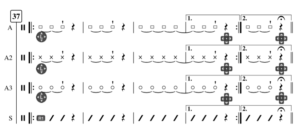PS Quartet No.2 is here! Five of EMEWS members recorded a version (Alex MacColl-Artrip, Sean Monaghan, Jacob Joslin, Ebony Swain, Gavin Langley), but four or more people can perform the piece. The only hardware needed besides the computer (either Mac or PC) is a Playstation DualShock controller. The interested ensemble can perform it with Logitech game controllers (F310 or similar on both Mac and PC) or XBox controller (Mac only). The piece runs on SuperCollider, a multi-platform audio software.
The links below contain score and SuperCollider patches. Feel free to contact me if you have any questions.
2023 Update – Participants at Nief-Norf Summer Festival presented PS Quartet No.2 during the 2022 Summer Festival! Here’s the video.

